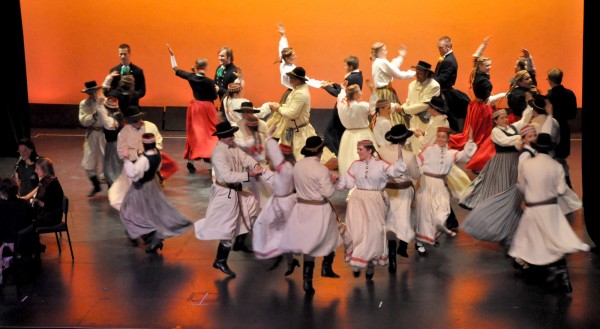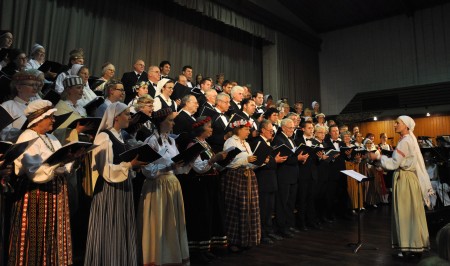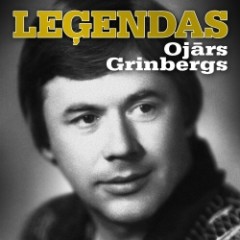
Latvian youth from Sydney, Melbourne, Canberra and Adelaide dancing at the folk dancing performance at Scott Theatre, Adelaide. Photo: Gunārs Nāgels.
Australian Latvians braved the heat of the Australian summer and came out in droves to take part in the biennial Latvian culture festival in December, 2012. This is the traditional expression of Latvian identity that has been the stalwart of the community since 1951.
For the past 60 years the Australian Latvian Kultūras dienas has provided three generations of Australians of Latvian descent with an annual burst of cultural energy to sustain them for the coming year.
Latvians in Australia have, since their arrival as refugees in the late 1940s, prided themselves on their cultural heritage. Just as the Latvians in the United States and Canada have regular Song Festivals – Dziesmu svētki – which alternate between the major cities either on the west or east coast or in the midwest, the Latvians in Australia have alternated their festivals, or Kultūras dienas, as they are known in Australia, among the capital cities of all States of Australia. As decades have gone by and communities in the smaller cities have dwindled, the main three cities to host the festivals now are Sydney, Melbourne and Adelaide.
What is the recipe to a successful Kultūras dienas? Is it a hefty dose of patriotic Latvian songs? Is it the vigorous dancing by the youth in the community at the folk dancing spectacular? Or the dancing at the traditional dance evening – danču vakars – that leaves you breathless but exhilarated? Is it the chance for Latvians of all ages to catch up with old friends and savour some Latvian culture at the same time? Or is it the strange sense of familiarity, maybe even belonging, that seems to overpower you as soon as you walk through the door at the Latvian House? I would dare to say – all of the above and more.
The first question that comes to mind is – why? This past decade Latvians have left their homeland in the tens of thousands for various reasons. A handful have also landed on Australian shores. Do the recent arrivals also take part in this decades-old tradition? A few do – and those active Latvians have brought fresh ideas and a different approach to their interpretation of the Latvian “way”. Yet many have not integrated with the older generation, even if they are of the same age group. A recent emigrant and a 3rd generation Australian-Latvian may find it a little strange to find a common language. Yet it is possible – and a successful marriage – at the Latvian Saturday schools. This is where the two worlds collide and Latvians who want to pass something of their language and cultural heritage on to their children gather under the same roof and strive for a common goal.
The culture days on Australian soil were held in Adelaide last December, just after Christmas. For six days until New Years’ Eve the Latvian language and music could be heard all around Adelaide. The older generation was happy to reconnect, while the younger crowd was happy to party together – Latvian style. This was most evident at the New Years’ Eve Ball at the National Wine Centre where the Latvian teenagers and twenty-somethings instantly flocked to the dance floor when the Latvian version of the popular Gangnam-style song by Psy started playing.
Over the past decade the cultural festival has had to rethink its future and slowly reinvent itself. If twenty, thirty years ago the festival could draw crowds of various thousands and singers in the choir and folk dancers could be counted in the hundreds, today the organisers have had to face reality and realise the numbers will never rival those of days gone by. But this does not mean the end of the event, just the dawn of a new more compact, dare I say more, cosy and welcoming festival. With smaller participant and audience numbers, the events have to be held at smaller venues (often the Latvian House) and the model has to be tweaked to get maximum interest from both the singers/dancers as well as the audience.
And so new events have been included, some even based on succesful counterparts in Latvia, such as the new “Lai dzied ģimenes” afternoon (based on Dziedošās ģimenes on Latvian TV) at the Adelaide festival. A well-attended event was the Family Fun Day with an Art and Crafts Market. These events cater for various generations and are relatively informal while at the same time they showcase various aspects of a uniquely Latvian frame of mind. The Latvian girl making Jāņu vaiņagi, inviting you to come and learn how to make one yourself was a good example of this. At the same time a crowd of children was trying out their skills on the basketball court, taking part in Latvian dancing games – rotaļas – and being whizzed around on an “ice sled”. The photo booth was also a great idea for friends and family to crowd together and have some fun.
Guest performers from Latvia are always a drawcard and the two groups from the homeland that came to enrich the festival were well received. Trio Šmite Kārkle Cinkuss and ansamblis Mūza showed their talents in various genres. While the former had a more traditional, even ancient, flavour to their music, albeit with a modern twist, the latter ensemble – Mūza – excelled in their performance of works by classical Latvian composers.
The old favourites – the folk dancing and choral concert – were both organised by the “younger generation” – (35-50 age bracket) and a breath of fresh air could be felt in both. The dance concert predominantly featured dances choreographed by Latvians living outside Latvia, a number of them Kultūras dienu participants themselves. The live music at the the dance concert provided by a group of Australian Latvian twenty-somethings, titled Vepons ov Rok proved that not only does the younger generation have musical talent but also a joie de vivre that spills over into the audience!
The joint choir concert was a success as many of the songs in the repertoire were well-known and favourites – and songs that will be sung in the Dziesmu svētki in Rīga this year. A good turnout of choristers, the ranks of which were replenished in the second half of the concert with the Adelaide Philharmonic Choir, all added to the quality of the choir and did not disappoint the audience which had surprised the organisers and filled the Latvian House to bursting point.
One positive feature of the new collaboration between the Latvian government and the diaspora is the interest that politicians and high-ranking government officials have shown in the cultural festivals in the diaspora. The US-Latvian Dziesmu svētki in Milwaukee was attended by the Minister of Culture, Žaneta Jaunzeme-Grende in July, 2012 and the Australian-Latvian equivalent was also on the Culture Minister’s agenda. As the Latvian government has placed emphasis on the ever-growing diaspora worldwide this would seem a natural place for the Minister to visit and see first-hand how the Australian Latvians celebrate the culture of their heritage. Jaunzeme-Grende attended most events and could frequently be seen networking with the local Latvian community members. The Minister also spoke at the opening ceremony and later at an information session where outlined the Latvian government’s new directions in the area of culture.
It is impossible to list the numerous different events that made these culture days a success. And it’s not really necessary as every person who took part – either in the audience or on stage – will have their own memories. It is these individual memories that all join together to form the collective memory of the intangible – the words “Kultūras dienas” seem to take on their own meaning in each of our minds. The memory of youth, of concerts from years ago, the memory of a first love, a night to remember, a feeling of Latvianness (latvietība). It is for this reason that the organisers are prepared to put in various years of hard work, why the participants are happy to attend rehearsals for weeks on end and why Latvians around Australia are still glad to gather in one place every two years to celebrate their heritage and their culture. May our community have the wisdom to continue evolving with the times to continue this tradition for many more decades!

The joint choir from all States of Australia singing at the cultural festival. Conductor Marija Perejma. Photo: Gunārs Nāgels.





